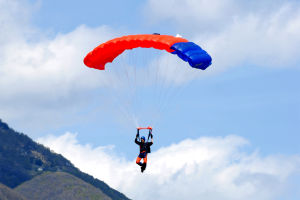The gliding umbrella is a type of aviation sports equipment that allows humans to fly like birds. It is a flying-wing aircraft that is currently popular in Europe, America, and Japan. Unlike traditional parachutes, gliding umbrellas offer a unique and exhilarating experience that combines sport and game.
The concept of gliding umbrellas originated in Europe during the early 1970s when some climbers discovered that they could glide down the mountainside, experiencing a sense of freedom and adventure. They later developed this experience into an emerging aviation sports project that has since become very popular.
Gliding umbrellas offer a unique state of freedom, as they allow individuals to soar through the sky, enjoying the tranquility and beauty of the world from a different perspective.
These aircraft are slow, gentle, and quiet, allowing pilots to float in the air elegantly. They offer a unique combination of sport and leisure, and many enthusiasts enjoy the experience of flying gliding umbrellas as a form of relaxation and escape.
The gliding umbrella can take off on a hillside and complete various flying movements such as hovering, gliding, climbing, and stagnation. It is highly maneuverable and stable, making it easy to control. The equipment for gliding umbrellas is also lightweight, compact, and easy to carry, with a total weight of only 10-20 kg.
Let's dive into some science behind gliding umbrellas:
How long can a flight last?
The duration of a flight depends on the flight conditions at the time. High-altitude flights can generally last several hours, and if the weather is good, the pilot does not need to land before sunset.
Where should the take-off and landing site for gliding umbrellas be chosen?
Any obstacle-free slope with a gradient of less than 6:1 can be used as a take-off site. When the wind speed is between 25-32 km/h, the pilot can take off by running down the hillside.
The landing site for a glider varies depending on the pilot's skill level, and experienced pilots can land on a flat surface without any obstacles. However, the selection of a landing site will also depend on the wind speed and the surrounding environment at that time.
How long does it take to learn to fly a gliding umbrella?
The time required to learn to fly a gliding umbrella will vary depending on personal learning ability and flight skills.
Typically, multiple ground training and simulation flights are required, followed by actual flights under the guidance of a coach. Beginners need to conduct at least 30-50 flight training sessions to become proficient in the operation skills of gliding umbrellas.
What weather conditions are suitable for flying a gliding umbrella?
Flying can only be performed under suitable weather conditions.
Typically, pilots should choose a day with low wind speeds, clear weather, no rain, no fog, and stable air pressure. Before flying, detailed meteorological analysis and judgment must be performed to ensure flight safety.
What safety precautions should be taken when flying a gliding umbrella?
Gliding umbrellas are a high-risk sport that requires pilots to have sufficient technology and security awareness.
Pilots should always prioritize safety during flight, avoiding adventure and staying within their skill level. Additionally, gliding umbrella equipment must undergo strict quality inspection and maintenance to ensure the stability and safety of the aircraft.
The gliding umbrella offers a unique opportunity for individuals to experience the freedom and adventure of flying. With the right equipment, training, and safety precautions, anyone can learn to fly a gliding umbrella and enjoy the experience of soaring through the sky like a bird.


